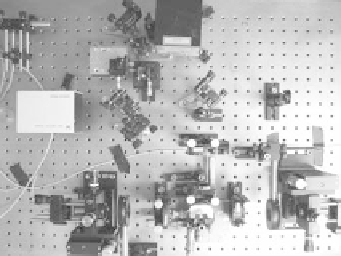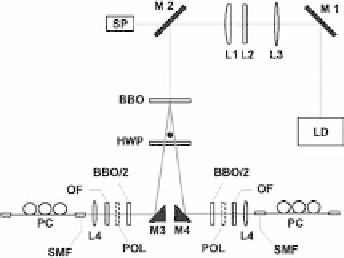Cryptography Reference
In-Depth Information
Figure 3.10
Sketch of the experimental implementation. The beam of a laser diode
(LD) is focused by a telescope (lenses L1, L2, and L3) onto the nonlinear crystal (BBO).
The photon pairs created by SPDC leave the crystal with an opening angle of 6
◦
,
passing a half-wave plate (HWP); the polarization of the photons is flipped before they
pass the two compensation crystals (BBO/2). Before they are coupled into a single-
mode optical fiber (SMF) by the coupling lens L4, they pass an optional polarizer
(POL) and an orange glass filter (OF) that blocks scattered UV light. To compensate
for arbitrary polarization rotation within the fiber, a polarization control module (PC)
is connected to the end of the SMF.
3.2.5.2.1 The Photon Source.
The entangled-photon source has been
inspired by the design of several previous experiments [72,73] (see Figure 3.10).
There, the entangled photons are created by spontaneous parametric down-
conversion in a nonlinear crystal. In our setup, a continuous wave (CW) violet
GaN laser diode was used to pump a nonlinear
-barium borate (BBO) crystal
with 18.6 mW optical power at 405 nm. To achieve a narrow line width, the
laser diode was mounted in Littrow configuration.
The pump beam was focused to a round waist of approximately 100
µm at the BBO crystal using a telescope lens system. Three lenses form an
imaging system in which an achromatic lens creates a distortion-free elliptical
focus that could then be imaged, astigmatically corrected, into the crystal.
The Rayleigh range of the pump beam is much longer than the length of the
BBO crystal used (4 mm long). We used a half-wave plate and a 2 mm long
BBO crystal for compensating for the transversal and longitudinal walkoff
effects [72] (see Figure 3.10). We assumed a gaussian distribution of angles
and rotational symmetry around the intersection lines for the emission of
entangled photons [73]. The collection efficiency was optimized by matching
the emission modes of the entangled photons with the modes accepted by the
fiber coupler.
The setup is aligned to produce the maximally entangled Bell singlet
state
β
1
√
2
(
|
|
ψ
−
=
H
|
V
−|
V
|
H
).
(3.2)
12
1
2
1
2











